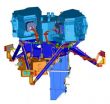(Press-News.org) What does it take to save a species in the 21st century? The specter of climate change, with predicted losses to biodiversity as high as 35 percent, has some scientists and managers considering taking their conservation strategies on the road.
Managed relocation (MR) is literally the physical relocation of endangered or threatened species of plants and animals, by humans, to new, and foreign geographical climes. It addresses the concern that climate shifts may make many species' historical ranges environmentally inhospitable, and that the rapid speed of change and habitat fragmentation will prevent them from adapting to these new conditions or moving themselves. And while conservationists argue that the practice may not preserve some species, such as the polar bear, relocation is a hotly debated option for others' long-term survival.
Arizona State University environmental ethicist Ben Minteer and ecologist James P. Collins ask hard questions about the practice, also known as assisted colonization, assisted migration or assisted translocation, in their article "Move it or Lose it" published October 1 in the journal Ecological Applications.
Stress on native species is just one of the unknowns that come into play with translocation of species. There also remains the more critical question of how to evaluate such management decisions, according to Minteer, an associate professor in ASU's School of Life Sciences and researcher in the Center for Biology and Society, and Collins, a Virginia G. Ullman Professor of Natural History and the Environment in ASU's School of Life Sciences in the College of Liberal Arts and Sciences.
"New approaches to conservation, such as MR mean the need for a new 'ecological ethics' geared toward problem-solving in ecological research and policy," says Minteer. "Beyond asking 'should' we do it, there's the more pragmatic ethical question: what separates a 'good' from a 'bad' MR activity?" In a time of rapid global change, Collins says that "ecologists and biodiversity managers will have to think hard about not only what management actions are possible, but also which ones are acceptable ethically."
Such discussion is as critical as the technical and scientific questions of relocation: the "can we do it and how we do it," the authors state.
Minteer points out that while moving species around is nothing new, the climate change rationale for doing so is. "Looking past creating parks and shielding species from bullets, bulldozers and oil spills in favor of the anticipatory relocation for conservation purposes strikes many as different, in terms of motive and perhaps the extent of the consequences."
Minteer and Collins's call to reassess conservation goals in the face of climate change is timely. While the practice has no guarantees of success, managed relocation of species is already being put into practice. The Florida torreya tree is an example, along with the proposed relocation of the Quino Checkerspot butterfly and the Iberian lynx.
Collins says that the real scientific concern with species relocation – voiced by prominent skeptics – is that crossing evolutionary boundaries via managed relocation will produce a number of negative ecological and genetic consequences for species and systems on the receiving end.
How to leap the ethical gulf separating decisions about which species should be moved and "saved" is also critical to the debate. Though some argue that human activity has already played an active role in shifting species and that some populations are "naturally" undergoing range shifts without assistance due to climate change in response to human pressures as well as natural ones.
However, as Minteer points out, "There is also the more philosophical objection to the fact that 'we' are doing this, rather than the populations themselves, and that this is therefore another example of human arrogance toward wild species and the environment more generally."
Does the shift to focus on relocation strategies mean that more traditional routes to preserve species, such as species migration corridors that connect forest patches, will become anachronistic?
"Traditional philosophy and policy of conserving species will likely change to reflect a more anticipatory and interventionist mode of thinking," Minteer says. "What this spells for conventional norms of ecological preservation is that they may have to give way to a more dynamic and 'novel systems' model rather than historical ones."
In other words, the "metabolism" of conservation will have to speed up to keep in step with climate change, Minteer believes.
Some believe that the distraction from the use of traditional protected areas and historical systems models, will also, once managed relocation is legitimized, open the floodgates and that people will start moving species willy nilly around the landscape. "I think that fear is exaggerated, though the precedent that would be set for ecological policy by formally adopting MR, even as a last resort, is indeed a significant issue," says Minteer.
"How to formulate new approaches to ecological research and management landscapes in an era of rapid and global environmental change raises original and difficult ethical questions about how to save species and protect landscapes," Collins states. "We can improve the decisions we make by using more collaborative and interdisciplinary approaches to such problem-solving and decision-making."
### END
Climate change forcing a 'move it or lose it' approach to species conservation?
2010-10-02
ELSE PRESS RELEASES FROM THIS DATE:
GOES-13 sees an unholy matrimony: Nicole and low pressure swamp the US East Coast
2010-10-02
In a "marriage" that U.S. east coast residents would object to, the remnants of Tropical Storm Nicole coupled with an upper level low pressure area have dumped record rainfall from the Carolinas to New England on Sept. 30. The GOES-13 Satellite captured that massive "union" of a system as it begins to push off the northeastern U.S. coast today, Oct. 1.
At 1401 UTC (10:01 a.m. EDT) on Oct. 1, the Geostationary Operational Environmental Satellite called GOES-13 captured a visible image of the extensive cloud cover of this coupled system. The GOES image shows the system's ...
NASA's Webb telescope MIRI instrument takes one step closer to space
2010-10-02
A major instrument due to fly aboard NASA's James Webb Space Telescope is getting its first taste of space in the test facilities at the Rutherford Appleton Laboratory (RAL) in the United Kingdom. The Mid-InfraRed Instrument (MIRI) has been designed to contribute to areas of investigation as diverse as the first light in the early Universe and the formation of planets around other stars.
"The start of space simulation testing of the MIRI is the last major engineering activity needed to enable its delivery to NASA. It represents the culmination of 8 years of work by the ...
Computer-aided detection is increasingly being used in screening and diagnostic mammography
2010-10-02
The use of computer-aided detection (CAD) is increasing, in both screening and diagnostic mammography, according to a study in the October issue of the Journal of the American College of Radiology (www.jacr.org). CAD software systems highlight and alert the radiologist of abnormal areas of density, mass or calcification on a digitized mammographic image (of the breast) that may indicate the presence of cancer.
Screening mammography is an X-ray exam of the breast that is used as a screening tool to detect early breast cancer in women experiencing no symptoms. Diagnostic ...
Measuring productivity helps radiology department improve efficiency
2010-10-02
Researchers working in a radiology department at a mid-sized hospital were able to increase productivity and improve efficiency by developing a simple method for measuring general technologist productivity, according to a study in the October issue of the Journal of the American College of Radiology (www.jacr.org).
"Improving productivity and maintaining team spirit are often competing priorities that may be difficult to achieve simultaneously," said C. Daniel Johnson, MD, co-author of the study. "In an era of cost reductions, radiology departments need to be able to ...
October 2010 Geosphere highlights
2010-10-02
Boulder, CO, USA - This month's themed issue, "Advances in 3D imaging and analysis of geomaterials," edited by Guilherme A.R. Gualda, Don R. Baker, and Margherita Polacci, features papers from the 2009 AGU Joint Assembly session "Advances in 3-D Imaging and Analysis of Rocks and Other Earth Materials." Studies include 3-D imaging and analysis techniques for Wild 2 comet material returned from the NASA Stardust mission and the first 3-D X-ray scans of crystals from the Dry Valleys, Antarctica.
Introduction: Advances in 3D imaging and analysis of geomaterials
Guilherme ...
Evaluation of targeted therapy in ovarian cancer
2010-10-02
Reston, Va.— Research reported in the October issue of The Journal of Nuclear Medicine (JNM) shows that a molecular imaging technique may prove useful in early assessment of treatment response for cisplatin-resistant ovarian cancer.
"One of the most promising aspects of molecular imaging is its potential capacity to measure therapy effects long before changes in the tumor size and shape are detected," said Marijke De Saint-Hubert, medical scientist in the Department of Nuclear Medicine at the University Hospital Gasthuisberg, Leuven, Belgium, and one of the authors on ...
Parkinson's disease: Excess of special protein identified as key to symptoms and possible new target for treatment with widely used anti-cancer drug imatinib
2010-10-02
Johns Hopkins scientists have discovered that the over-activation of a single protein may shut down the brain-protecting effects of a molecule and facilitate the most common form of Parkinson's disease. The finding of this mechanism could lead to important new targets for drugs already known to inhibit it, thus controlling symptoms of the disorder, which affects about 1 million older Americans.
Previous research demonstrated that a protein called parkin protects brain cells by "tagging" certain toxic elements that are then destroyed naturally. It was also known that ...
Johns Hopkins researchers turn off severe food allergies in mice
2010-10-02
Johns Hopkins Medicine
Johns Hopkins scientists have discovered a way to turn off the immune system's allergic reaction to certain food proteins in mice, a discovery that could have implications for the millions of people who suffer severe reactions to foods, such as peanuts and milk.
The findings, published online in the journal Nature Medicine, provide hope that the body could be trained to tolerate food allergies that lead to roughly 300,000 emergency room visits and 100 to 200 deaths each year.
The research team, led by Shau-Ku Huang, Ph.D., a professor of medicine, ...
Lifestyle intervention improves risk factors in type 2 diabetes
2010-10-02
An intensive lifestyle intervention program designed to achieve and maintain weight loss improves diabetes control and cardiovascular disease risk factors in overweight and obese individuals with type 2 diabetes, according to four-year results of the Look AHEAD study, funded by the National Institutes of Health and the Centers for Disease Control and Prevention. The results are published in the Sept. 27, 2010, issue of the Archives of Internal Medicine.
Look AHEAD (Action for Health in Diabetes) is a multi-center, randomized clinical trial investigating the effects of ...
Break the Boredom of Holiday Gift Shopping with the Karuna Karma Kit
2010-10-02
Every holiday season shoppers eagerly queue up to buy gifts that are sure to please. This year, Karuna Skin, LLC, a privately held luxury skin care company in Los Angeles, recently launched an exceptional gift called the Karma Kit, a premium collection of its four best-selling Karuna masks including the hydrating mask, anti-oxidant mask, exfoliating mask and anti-aging mask.
Karuna, which is the first skincare company to develop a high-quality, one-step, no-mess, no-rinse, do-it-yourself facial that is individually wrapped, developed the Karma Kit as a natural extension ...

